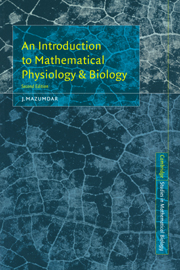Book contents
- Frontmatter
- Contents
- PREFACE TO THE SECOND EDITION
- PREFACE TO THE FIRST EDITION
- Chapter 1 DIMENSIONAL ANALYSIS IN MATHEMATICAL PHYSIOLOGY
- Chapter 2 THE MATHEMATICS OF DIFFUSION
- Chapter 3 POPULATION BIOLOGY
- Chapter 4 BIOGEOGRAPHY: MATHEMATICAL ANALYSIS OF WILDLIFE RESERVES
- Chapter 5 PHARMACOKINETICS: DRUG DISTRIBUTION IN PHARMACOLOGY
- Chapter 6 MATHEMATICAL MODELLING IN EPIDEMIOLOGY
- Chapter 7 MODELLING THE AIDS EPIDEMIC
- Chapter 8 BIOLOGICAL FLUID MECHANICS
- Chapter 9 ANALYSIS AND APPLICATIONS OF LEFT VENTRICULAR MECHANICS
- Chapter 10 ANALYSIS AND APPLICATIONS OF HEART VALVE VIBRATION
- Chapter 11 MEDICAL DEVICES
- GLOSSARY OF TERMS
- REFERENCES
- INDEX
Chapter 10 - ANALYSIS AND APPLICATIONS OF HEART VALVE VIBRATION
Published online by Cambridge University Press: 05 June 2012
- Frontmatter
- Contents
- PREFACE TO THE SECOND EDITION
- PREFACE TO THE FIRST EDITION
- Chapter 1 DIMENSIONAL ANALYSIS IN MATHEMATICAL PHYSIOLOGY
- Chapter 2 THE MATHEMATICS OF DIFFUSION
- Chapter 3 POPULATION BIOLOGY
- Chapter 4 BIOGEOGRAPHY: MATHEMATICAL ANALYSIS OF WILDLIFE RESERVES
- Chapter 5 PHARMACOKINETICS: DRUG DISTRIBUTION IN PHARMACOLOGY
- Chapter 6 MATHEMATICAL MODELLING IN EPIDEMIOLOGY
- Chapter 7 MODELLING THE AIDS EPIDEMIC
- Chapter 8 BIOLOGICAL FLUID MECHANICS
- Chapter 9 ANALYSIS AND APPLICATIONS OF LEFT VENTRICULAR MECHANICS
- Chapter 10 ANALYSIS AND APPLICATIONS OF HEART VALVE VIBRATION
- Chapter 11 MEDICAL DEVICES
- GLOSSARY OF TERMS
- REFERENCES
- INDEX
Summary
Basic Concepts
The heart valves are mechanical devices that permit the flow of blood in one direction only. The two cuspid (atrio-ventricular) valves are located between the atria and ventricles, while the two semi-lunar valves are located at the entrance to the pulmonary artery and the great aorta. The cuspid valves prevent blood from flowing back into the atria from the ventricles and the semi-lunar valves prevent it from being regurgitated back into the ventricles from the aorta and pulmonary artery.
Any one of the four valves may lose its ability to close tightly; such a condition is known as valvular insufficiency or regurgitation. On the other hand, stenosis is an abnormality in which the fully open valvular orifice becomes narrowed by scar tissue that forms as a result of valvular disease; thereby the blood flow through the valve results in increased pressure drop across the valve orifice.
Here, we will address ourselves to aspects concerning the noninvasive assessment of valvular pathology, as characterized by its nonlinear constitutive property. In order to do so, we need to incorporate the noninvasive measurements of cardiac mechanical events, associated with valvular mechanics, that are available to us. One such set of measurements constitutes monitoring the geometry of cardiac structures by means of two-dimensional echocardiography. The heart sounds constitute yet another set of noninvasive data which can be utilized.
The acoustic waves (due to cardiac structual vibrations associated with cardiac mechanical events) that are transmitted to the chest contain information on the vibratory source.
- Type
- Chapter
- Information
- An Introduction to Mathematical Physiology and Biology , pp. 186 - 207Publisher: Cambridge University PressPrint publication year: 1999



